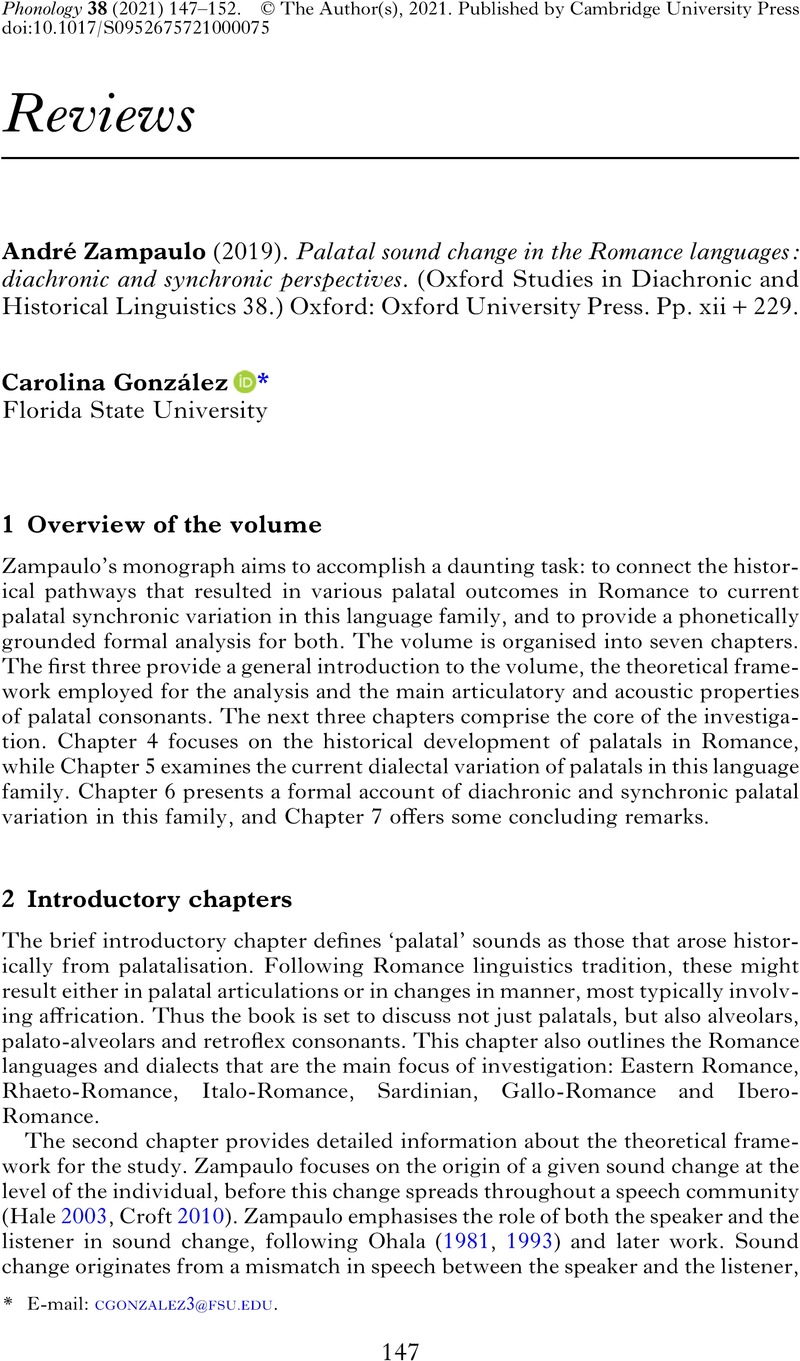No CrossRef data available.
Article contents
André Zampaulo (2019). Palatal sound change in the Romance languages: diachronic and synchronic perspectives. (Oxford Studies in Diachronic and Historical Linguistics 38.) Oxford: Oxford University Press. Pp. xii + 229.
Review products
André Zampaulo (2019). Palatal sound change in the Romance languages: diachronic and synchronic perspectives. (Oxford Studies in Diachronic and Historical Linguistics 38.) Oxford: Oxford University Press. Pp. xii + 229.
Published online by Cambridge University Press: 02 July 2021
Abstract
An abstract is not available for this content so a preview has been provided. Please use the Get access link above for information on how to access this content.

- Type
- Review
- Information
- Copyright
- Copyright © The Author(s), 2021. Published by Cambridge University Press
References
Baker, Gary K. (2004). Palatal phenomena in Spanish phonology. PhD dissertation, University of Florida.Google Scholar
Bateman, Nicoleta (2007). A crosslinguistic investigation of palatalization. PhD dissertation, University of California, San Diego.Google Scholar
Browman, Catherine P. & Goldstein, Louis (1989). Articulatory gestures as phonological units. Phonology 6. 201–251.CrossRefGoogle Scholar
Colantoni, Laura & Hualde, José Ignacio (2013). Introducción: variación fonológica en el español de la Argentina. In Colantoni, Laura & Louro, Celeste Rodríguez (eds.) Perspectivas teóricas y experimentales sobre el español de la Argentina. Madrid & Frankfurt am Main: Iberoamericana & Vervuert. 21–35.CrossRefGoogle Scholar
Croft, William (2010). The origins of grammaticalization in the verbalization of experience. Linguistics 48. 1–48.CrossRefGoogle Scholar
González, Carolina (2014). Prevocalic velar advancement in Chilean Spanish and Proto-Romance. In Côté, Marie-Hélène & Mathieu, Éric (eds.) Variation within and across Romance languages: selected papers from the 41st Linguistic Symposium on Romance Languages (LSRL), Ottawa, 5-7 May 2011. Amsterdam & Philadelphia: Benjamins. 277–295.Google Scholar
Hale, Mark (2003). Neogrammarian sound change. In Joseph, Brian D. & Janda, Richard D. (eds.) The handbook of historical linguistics. Malden, MA & Oxford: Blackwell. 343–368.CrossRefGoogle Scholar
Hayes, Bruce, Kirchner, Robert & Steriade, Donca (eds.) (2004). Phonetically based phonology. Cambridge: Cambridge University Press.CrossRefGoogle Scholar
Hayes, Bruce & Steriade, Donca (2004). Introduction: the phonetic bases of phonological markedness. In Hayes et al. (). 1–33.CrossRefGoogle Scholar
Holt, D. Eric (1997). The role of the listener in the historical phonology of Spanish and Portuguese: an optimality-theoretic account. PhD dissertation, Georgetown University.Google Scholar
Hualde, José Ignacio (2014). Los sonidos del español. Cambridge: Cambridge University Press.Google Scholar
Kirchner, Robert (1998). An effort-based approach to consonant lenition. PhD dissertation, University of California, Los Angeles. Published 2001, New York & London: Routledge.Google Scholar
Martínez-Gil, Fernando (2020). Spirantization and the phonology of Spanish voiced obstruents. In Colina, Sonia & Martínez-Gil, Fernando (eds.) The Routledge handbook of Spanish phonology. London & New York: Routledge. 34–83.Google Scholar
Menéndez Pidal, Ramón (1950). Orígenes del español: estado lingüístico de la península ibérica hasta el siglo XI. 3rd edn. Madrid: Espasa-Calpe.Google Scholar
Ohala, John J. (1981). The listener as a source of sound change. In Masek, C. S., Hendrick, R. A. & Miller, M. F. (eds.) Papers from the parasession on language and behavior. Chicago: Chicago Linguistic Society. 178–203.Google Scholar
Ohala, John J. (1993). The phonetics of sound change. In Jones, Charles (ed.) Historical linguistics: problems and perspectives. London & New York: Longman. 237–278.Google Scholar
Penny, Ralph (2002). A history of the Spanish language. 2nd edn. Cambridge: Cambridge University Press.CrossRefGoogle Scholar
Prince, Alan & Smolensky, Paul (2004). Optimality Theory: constraint interaction in generative grammar. Malden, MA & Oxford: Blackwell.CrossRefGoogle Scholar
Recasens, Daniel (2013). On the articulatory classification of (alveolo)palatal consonants. Journal of the International Phonetic Association 43. 1–22.CrossRefGoogle Scholar
Rini, Joel (1991). Metathesis of yod and the palatalization of Latin medial /k'l/, /g'l/, /t'l/; /ks/, /ssj/, /sj/; /kt/, /ult/ in Hispano- and Luso-Romance. In Harris-Northall, Ray & Cravens, Thomas D. (eds.) Linguistic studies in Medieval Spanish. Madison: Hispanic Seminary of Medieval Studies. 109–133.Google Scholar
Wireback, Kenneth J. (1997). The role of phonological structure in sound change from Latin to Spanish and Portuguese. New York: Lang.Google Scholar





